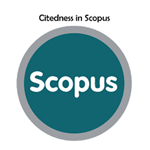Kepatuhan Minum Obat Antidiabetika Oral Pasien Ulkus Diabetikum Rawat Jalan di Klinik X Kota Pontianak Menggunakan Metode Kuantitatif
Abstract
Keywords
Full Text:
PDFReferences
. A. S. Al-Goblan, M. A. Al-Alfi, and M. Z. Khan, "Mechanism linking diabetes mellitus and obesity" Diabetes, Metab. Syndr. Obes. targets Ther., pp. 587-591, 2014.
. S. Suyono, "Diabetes melitus di Indonesia: buku ajar ilmu penyakit dalam jilid III edisi V" Jakarta. Balai Penerbit Fak. Kedokt. Univ. Indones. Jakarta, vol. 1134, 2009.
. A. Ridwan et al., "HUBUNGAN PENGETAHUAN TENTANG DIET DIABETES MELLITUS DENGAN PERILAKU DIET PENDERITA DIABETES MELLITUS."
. E. Alkendhy, "Analisis faktor-faktor terjadinya luka kaki diabetes berulang pada pasien diabetes melitus di Klinik Kitamura dan RSUD Dr. Soedarso Pontianak" ProNers, vol. 4, no. 1, 2019.
. P. E. Indonesia, "Pengelolaan dan pencegahan diabetes melitus tipe 2 di Indonesia" Pb. Perkeni, 2015.
. J. S. Kekenusa, B. T. Ratag, and G. Wuwungan, "Analisis hubungan antara umur dan riwayat keluarga menderita DM dengan kejadian penyakit DM tipe 2 pada pasien rawat jalan di Poliklinik Penyakit Dalam BLU RSUP PROF" J. Kesmas Univ. Sam Ratulangi Manad., vol. 2, no. 1, pp. 1-6, 2013.
. L. Malfirani and N. U. Purwanti, "ANALISIS KEPATUHAN PENGOBATAN PASIEN DIABETES MELITUS TIPE 2 RAWAT JALAN DI PUSKESMAS KAMPUNG BANGKA PONTIANAK TENGGARA PERIODE JULI 2017-DESEMBER 2018" J. Mhs. Farm. Fak. Kedokt. UNTAN, vol. 4, no. 1, 2019.
. S. Notoatmodjo, "Metodologi penelitian kesehatan" 2005.
. D. Efayanti, "Analisis faktor yang mempengaruhi kepatuhan pengambilan obat peserta program rujuk balik di Bandar Lampung" J. Farm. Indones. Vol, vol. 9, no. 1, 2017.
. M. P. B. Gumantara and R. Z. Oktarlina, "Perbandingan monoterapi dan kombinasi terapi sulfonilurea-metformin terhadap pasien diabetes melitus tipe 2" J. Major., vol. 6, no. 1, pp. 55-59, 2017.
. A. Akrom, O. M. Sari, and Z. Saputri, "Analisis determinan faktor-faktor yang berhubungan dengan kepatuhan minum obat pasien diabetes tipe 2 di pelayanan kesehatan primer" J. Sains Farm. Klin., vol. 6, no. 1, pp. 54-62, 2019.
. F. D. Marinda, J. F. Suwandi, and A. Karyus, "Tatalaksana Farmakologi Diabetes Melitus Tipe 2 pada Wanita Lansia dengan Kadar Gula Tidak Terkontrol" MEDULA, medicalprofession J. lampung Univ., vol. 5, no. 2, 2016.
. M. A. B. Khan, M. J. Hashim, J. K. King, R. D. Govender, H. Mustafa, and J. Al Kaabi, "Epidemiology of type 2 diabetes-global burden of disease and forecasted trends" J. Epidemiol. Glob. Health, vol. 10, no. 1, p. 107, 2020.
. S. A. Soelistijo et al., "Konsensus pengelolaan dan pencegahan diabetes melitus tipe 2 di Indonesia 2015" Jakarta PB Perkeni, vol. 2, no. 1, pp. 1-93, 2015.
. S. L. Lubis, G. T. Utami, and Y. I. Dewi, "Gambaran Gaya Hidup Anggota Keluarga Berisiko Diabetes Melitus (DM) Tipe 2" J. Online Mhs. Bid. Ilmu Keperawatan, vol. 5, no. 2, pp. 155-163, 2016.
. N. Husniawati, "Faktor-faktor yang Berhubungan dengan Kejadian Ulkus Kaki Diabetes Melitus di Klinik Diabetes Melitus Tahun 2015" J. Ilmu Kesehat., vol. 7, no. 2, pp. 138-143, 2015.
. D. D. Lestari, K. M. Winahyu, and S. Anwar, "Kepatuhan Diet pada Klien Diabetes Melitus Tipe 2 Ditinjau dari Dukungan Keluarga di Puskesmas Cipondoh Tangerang" J. Ilm. Keperawatan Indones., vol. 2, no. 1, pp. 83-94, 2018.
. Z. Punthakee, R. Goldenberg, and P. Katz, "Definition, classification and diagnosis of diabetes, prediabetes and metabolic syndrome" Can. J. diabetes, vol. 42, pp. S10-S15, 2018.
. C. M. Kozma, M. Dickson, A. L. Phillips, and D. M. Meletiche, "Medication possession ratio: implications of using fixed and variable observation periods in assessing adherence with disease-modifying drugs in patients with multiple sclerosis" Patient Prefer. Adherence, pp. 509-516, 2013.
DOI: https://doi.org/10.37311/ijpe.v3i1.19276
Refbacks
- There are currently no refbacks.
Copyright (c) 2023 Prita Laoura, Nurmainah Nurmainah, Ressi Susanti

Indonesian Journal of Pharmaceutical Education is licensed under a Creative Commons Attribution-NonCommercial-ShareAlike 4.0 International License.



